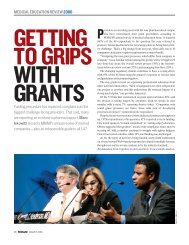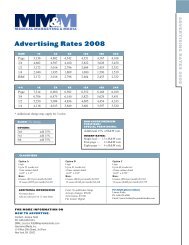Essential Guide to E-mail Marketing - Haymarket
Essential Guide to E-mail Marketing - Haymarket
Essential Guide to E-mail Marketing - Haymarket
You also want an ePaper? Increase the reach of your titles
YUMPU automatically turns print PDFs into web optimized ePapers that Google loves.
28 INFRASTRUCTURE DM News • E-Mail <strong>Marketing</strong> <strong>Guide</strong> 2007<br />
E-<strong>mail</strong> authentication:<br />
It’s time<br />
BY AL IVERSON<br />
ISPs like Hot<strong>mail</strong> have been pushing e-<strong>mail</strong> authentication for<br />
years. I’ve been talking about Sender ID and Hot<strong>mail</strong> for more<br />
than two years now and Meng Wong (now of Karmasphere) has<br />
been educating senders and receivers on why sender policy framework<br />
(SPF) is important since at least mid-2004.<br />
For a long time, it seemed like a solution in search of a problem.<br />
Common questions included,<br />
what does e-<strong>mail</strong> authentication<br />
do, why should one invest in a<br />
new technology, and if <strong>mail</strong> is getting<br />
through fine. There simply<br />
didn’t seem <strong>to</strong> be a good enough,<br />
or compelling enough reason for<br />
most senders <strong>to</strong> start authenticating<br />
their <strong>mail</strong>.<br />
But now the industry recognizes<br />
that there are significant delivery<br />
benefits for senders who authenti-<br />
Al Iverson<br />
cate their <strong>mail</strong>.<br />
ExactTarget<br />
There are now three primary<br />
authentication technologies in play: Sender ID, SPF and<br />
DomainKeys/DKIM (DomainKeys Identified Mail). Here’s a simple<br />
overview.<br />
Sender ID just got very important at Hot<strong>mail</strong>. Sender ID is an<br />
integral component of getting your e-<strong>mail</strong> <strong>to</strong> any inbox at<br />
Hot<strong>mail</strong>. If you’re not doing Sender ID, or your Sender ID<br />
records are set up incorrectly, you’re going <strong>to</strong> have issues soon, if<br />
not already. Hot<strong>mail</strong> has clarified on numerous occasions and in<br />
numerous venues that if you publish a Sender ID record, and do<br />
it correctly, it improves your ability <strong>to</strong> deliver <strong>mail</strong>.<br />
DomainKeys (soon <strong>to</strong> be replaced by DKIM) is the authentication<br />
technology most important <strong>to</strong> Yahoo. What’s the benefit? If<br />
you want <strong>to</strong> participate in Yahoo’s feedback loop, you need <strong>to</strong> sign<br />
your <strong>mail</strong> with DomainKeys. If you don’t have DomainKeys<br />
authentication in place, you won’t receive spam complaint data<br />
back from Yahoo users. Senders who utilize feedback loops enjoy<br />
better deliverability. Yahoo is a large enough receiving site that any<br />
spam-blocking issues are sure <strong>to</strong> have a huge negative impact on<br />
e-<strong>mail</strong> performance.<br />
SPF matters, <strong>to</strong>o. Sender ID is backwards-compatible with SPF,<br />
so you need <strong>to</strong> be doing at least one or the other <strong>to</strong> prevent<br />
Hot<strong>mail</strong> issues. SPF will also give you a modest delivery boost at a<br />
few other ISPs, with the promise that more are <strong>to</strong> come. Since it’s<br />
the easiest technology <strong>to</strong> implement, at the very least, you should<br />
be utilizing SPF. It’s a simple text record you put in DNS, and it’s<br />
something you should immediately task your server administra<strong>to</strong>rs<br />
(or e-<strong>mail</strong> service providers) with helping you implement.<br />
Authenticate <strong>to</strong>day and the benefits won’t be limited <strong>to</strong> better<br />
deliverability with Hot<strong>mail</strong> and participation in Yahoo’s feedback<br />
loop. As more and more receiving sites and spam filters begin<br />
looking for e-<strong>mail</strong> authentication, the benefits will multiply.<br />
Al Iverson is direc<strong>to</strong>r of privacy and deliverability at ExactTarget. You can<br />
reach him at aiverson@exacttarget.com.<br />
ESSENTIAL GUIDE<br />
How marketers can prevent<br />
spam complaints<br />
BY BEN CHESTNUT<br />
You don’t have <strong>to</strong> be a spammer <strong>to</strong> get reported for spamming.<br />
Even <strong>to</strong>tally clean, 100 percent double opt-in lists will get one<br />
or two abuse reports per 50,000 recipients. Sometimes it’s just a<br />
simple mistake, but getting reported for abuse is pretty serious. If a<br />
major ISP receives even a small handful of complaints about your<br />
e-<strong>mail</strong>s, it will start blocking all e-<strong>mail</strong> from your server.<br />
So it’s worth looking at how legitimate e-<strong>mail</strong> marketers get<br />
falsely accused of sending spam.<br />
Sometimes, it’s a simple mistake. But more often than not, it’s<br />
the marketers’ own fault, caused by one or more of these actions:<br />
■ The marketer collected e-<strong>mail</strong>s legitimately, but <strong>to</strong>ok <strong>to</strong>o long <strong>to</strong><br />
make contact. People receive full-blown e-<strong>mail</strong> newsletters and<br />
they don’t remember opting in two years ago.<br />
■ The marketer runs an online s<strong>to</strong>re that yields thousands of<br />
e-<strong>mail</strong> addresses of cus<strong>to</strong>mers who have purchased products in the<br />
past. Instead of asking people <strong>to</strong> join the e-<strong>mail</strong> marketing list, the<br />
marketer just start blasting offers out.<br />
■ The marketer is exhibiting at a trade show that has provided a<br />
list of attendee e-<strong>mail</strong> addresses. Instead of e-<strong>mail</strong>ing those people<br />
an invitation <strong>to</strong> join its list, the marketer just assumes it has permission<br />
and starts e-<strong>mail</strong>ing<br />
newsletters and promos.<br />
■ Fish bowls and business cards.<br />
To marketers, it's common sense<br />
that this is a list-collection technique.<br />
To prospects, it’s just a free<br />
lunch.<br />
■ Purchasing or renting members’<br />
e-<strong>mail</strong> addresses from an<br />
organization, then just adding<br />
them <strong>to</strong> the list without getting<br />
permission.<br />
Ben Chestnut<br />
MailChimp.com<br />
Ways <strong>to</strong> Prevent Abuse Reports<br />
■ Use the double opt-in method. This way you have proof that<br />
each and every recipient gave permission <strong>to</strong> send them e-<strong>mail</strong>s.<br />
■ Even if they’re your cus<strong>to</strong>mers, don’t send promotions without<br />
permission. Set up a separate “marketing list” for cus<strong>to</strong>mers <strong>to</strong><br />
join. Give them reasons (or free prizes) for signing up.<br />
■ Don’t hide your opt-out link. Make it very prominent. Some<br />
marketers are placing the “Unsubscribe” link at the <strong>to</strong>p of their<br />
e-<strong>mail</strong>s, so they’re easy <strong>to</strong> find. We think this is a best practice.<br />
■ Make sure your e-<strong>mail</strong> looks reputable and professional so that<br />
people will trust your unsubscribe link.<br />
Ben Chestnut is the co-founder and managing partner of MailChimp.com. He<br />
can be reached at ben@<strong>mail</strong>chimp.com.
















